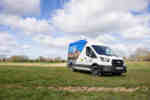New cars are generally in short supply, as there is no car manufacturing in the Republic, and the Southern Irish market tends to be commercially neglected by outsiders so supply is lower than demand.
Adding to this is the fact that so many new cars are exported to the UK, where they are relatively cheaper, further reducing new car availability.
This means strong demand in the nearly-new market, with cars registered in 1999 being especially sought after. Now another factor has come into play. Since February 2000 all cars registered before 1992 have to have an MoT-type test, which next year will be extended to cars registered before 1994.
This is likely to put many people off older cars and the signs already are that many are moving up the age ranges for their next vehicle. These are good times for quality used sales operations and some of the more inventive dealers are even offering 'scrappage' money for older cars, thus taking some of the oldest off the roads and generally stimulating further demand for 'nicer' cars.
Despite geographical or even social similarities many neighbouring European countries have very different car markets. Belgium and the Netherlands provide a good example. The Dutch are by far the more image conscious, with older cars almost unwanted.
This means very little interest in anything older than nearly new. In Belgium, however, it is a case of 'if it drives I'll take it', with cars retailable regardless of age. The car of choice is also very different between the two nations. The Belgians tend to like French cars, while the Dutch prefer Japanese. The latter also have a new favourite in the Rover 75 - this year's car to be seen in.
Last month we discussed the flow of used cars from Western Europe into Eastern Europe, fulfilling the need for cheap private transport in the former eastern bloc. In addition, the geographical position of the Eastern European market allows for outflows of used cars as well as inflows. For example, the location and relatively low living standards (in terms of average incomes) in Greece mean that there is also a steady demand for cheap Eastern European cars.
In Greece these cars - together with superminis, lower medium and the cheaper 4x4 vehicles - continue to be the most popular on the used market. Affordability and ease of maintenance have traditionally been the major issues here, with consequently low residual values across the market.
However, growing affluence in Greece over the past 10 years has led to an increase in demand for Western European vehicles, and this in turn is gradually being reflected on the used market. Sales of Western European cars, particularly those from Fiat and Volkswagen, along with Japanese vehicles, have increased significantly in recent years.
But there is some way to go before Greece reaches a similar point to much of western mainland Europe. The car parc is still weighted heavily towards cars 10 or more years old which means continued demand for the cheapest possible cars. (May 2000)
















Login to comment
Comments
No comments have been made yet.